 My wife and I have wanted to go to Europe longer than we have known each other. Rebecca has envisioned the backdrops of France, Greece, and Italy as her ultimate honeymoon since she was young. I always had in mind a visit to the castles of Germany and the British Isles. These all remained fantasies though. We stayed in the country for our honeymoon—having an extraordinary time in a few luxurious resorts of the redrock deserts in Utah—and have continued to dream of our eventual trip to Europe.
My wife and I have wanted to go to Europe longer than we have known each other. Rebecca has envisioned the backdrops of France, Greece, and Italy as her ultimate honeymoon since she was young. I always had in mind a visit to the castles of Germany and the British Isles. These all remained fantasies though. We stayed in the country for our honeymoon—having an extraordinary time in a few luxurious resorts of the redrock deserts in Utah—and have continued to dream of our eventual trip to Europe.Through the years I have somehow picked up the notion that in order to go anywhere far away and truly enjoy yourself, you need to take an extended trip. I thought it would be foolish and costly to fly across the world to stay for only a few nights. That philosophy has led to the quiet death of more than one potential weekend of travel.
A few months ago, we set aside time for a vacation this October, the first one since our daughter was born. The months crawled by, closing in on the date as we surfed the net for vacation deals. We had a dream vacation in the works to go to Ireland, slowly building an idea of where we wanted to go, and what we wanted to do once there. Then, just a few months back, we made the decision that we needed to save more money; I was in the middle of a planned job change, and school and other expenses were still, as of yet, unknown. Ireland was again put on a back burner, and we began looking a little more local.
Time was moving on quickly. Katie was growing, babbling, crawling, and then walking. But we were so busy, exhausted, and discouraged by the hectic and busy turn that our lives had taken in the last year that we could find nowhere that spoke to us of rest and relaxation. Even the inspiration and the desire to sit down and plan an escape were gone. There was the baby to consider. There was work. Our schedules were ridiculous, and even on vacation it was looking like we would be working.
A few days before we were supposed to leave, my mom flew into North Carolina. She would stay and watch our little girl while we relaxed somewhere on our second honeymoon.
Only one problem: we still did not know where we were going.
Two days before our vacation started, we were just narrowing it down to a road trip somewhere along the Atlantic coast. Talk about failure to plan. My wife made the suggestion to drive down to Charleston, South Carolina, for the historic feel to the city, and the ghost tours of the old buildings. I liked the idea, so we rented a car and packed up. We did not have anything planned for lodging or food, or even specific sites to see, just a spot on a map. So we packed the tent and our sleeping bags, and everything else that we thought we might need on our improvised odyssey.
We were on the road, thirty minutes away from our home when my wife called a friend, who reminded us that the military had free flights for military families out of Charleston to Spain and Germany.
Spain.
Europe.
Rebecca got off of the phone, and we looked at each other, the unasked question very clear. I was already slowing down and getting ready to turn the car back for Jacksonville.
Back home, we rummaged in the garage until we found our passports—great place to keep legal documents—and ran back to the car as my bewildered mom laughed and held little Katie.
We did not know how we were going to swing it in the few days we had free, and we did not know whether the vacation would end up being more of a hassle than a relaxation. We did not even know if we would be able to get on the plane, for scheduling concerns, passport concerns, and a billion other little problems that seemed to rise into some unmountable wall. But we were determined to try.
We got to Charleston with enough time to drive to the beach and eat dinner at a nice little seafood joint next to the water, then drove back to the city and onto the Air Force base, where we went through the procedures required to be included on the military flight to Spain.
We were in a daze the entire waiting period, still unsure as to whether this was reality or a dream. It was the equivalent to a how a child would feel if all of a sudden he or she learned that Christmas would come twice this year. We kept talking about all of the things that we would do once we got there, the sites we would see, the food we would try, the dialects of Spanish that we would hear.
Our flight would take us to a place on the southwest coast of Spain, a town called Rota, which boasts an American Navy base. It was in the Andalucia area of Spain, the Mediterranean part of the country that boasts Moorish architecture, spicy food, and a warm climate. As we looked in our travel guide, we found plenty of castles, exotic Roman and Moorish ruins, and plenty of other mouth-watering attractions with which to sate some of our appetite.
Over and over we would look at each other in wonder.
Spain.
We were going to Spain.
Our flight was classified as Space Available, which means the military sticks you on a cargo jet, if they have room for you. Then you have to plan a return trip, again, if they have room. There were a dozen or so of us stuffed onto a plane full of armored vehicles destined for Iraq. The eight-hour flight on folding seats in a chilly aircraft was not the mahogany and suede image of luxury, but on a free flight you get what you pay for.
We stepped off of the plane into the surprisingly dry climate of south-western Spain, Andalucian ground. There was a moment of blockbuster-quality slowed time where we both simply looked to each other and smiled. We were in Europe.
Granted, we were still on an American military base, but we were there. It was already very late, so we spent the night in cheap military lodging and set off in the morning to rent another car and have my wife’s passport stamped. We had been given a ton of vague information on the correct procedure to make sure you are allowed back in the States, or are even able to successfully get a seat on a return flight. So we rushed around until the afternoon of that first day chasing stamps, papers, and signatures. As we went, we made hasty, adrenaline-fueled plans, like the huddle before the last down.
Then we were free. We had a little car—when I say little, I really mean little. Even their freight trucks are small. While I am sure that there are other reasons beside, we found out that Europeans drive tiny cars because anything bigger does not fit on their narrow streets. We drove down the Atlantic coast to an ancient town called Cádiz, the port where Cristopher Columbus set sail for the Americas on more than one occasion, and the oldest continually inhabited city in western Europe.
Cádiz was not at all the small village that I was expecting. There is a large, bustling downtown area where buses, toy cars, and throngs of people hurry from point A to point B throughout their day. But as we closed in on the historic area of town, we found archaic chapels, mansions, and fortresses, all crammed into the urban maze that is European city planning. There is a large castle out on a stretch of rocks, coral, and sand, accessible by a long stone causeway. People were off of the walkway, catching crabs and fish in the hundreds of tidal pools along the way. We found the castle gates locked, but were delighted to find the rocks an exotic playground in their own right. Anemones, sea urchins, shrimp, crabs of various size and color, and darting fish all inhabited these hidden basins of water among the treacherous footing of the jagged stone and broken coral. The incoming tide surged through tunnels in the coral, crashing up like mini geysers as we picked our way among the sharp crags and small pools.
We strolled through the streets until late that evening, enjoying the crowds, the old buildings and the atmosphere of the antique port. Finally, suffering from jetlag, tired and stressed out, we slept in our car while the gaditanos, as the residents of the old city are known, partied around us until the early hours of the morning.
The next morning, relaxing in bed until ten or eleven in the morning, we headed straight to Seville, the fourth largest metropolitan area in Spain, and an area with much historical and artistic value. If Cádiz was large, then Seville was immense. A bustling city if I have ever seen one; it reminded me of Buenos Aires, only more open. We were there on a Sunday, and still there were people and vehicles everywhere. We were searching for a local branch of our church there in Seville, and even after figuring out how to get there, it still took us another thirty minutes just to find a parking spot.
Let me warn you now how easy it is to get lost in the tight streets between 18th century—and older—buildings. On the map, you see where you are, and where you want to go. Then you get there and you find that you cannot just drive straight down the easiest route in order to reach your destination. Partly because the roads are rarely straight, and rarely last for more than two or three blocks before t-boning or making a lazy curve in some other direction. But even more confusing is the fact that all of these inner city roads are one-way. The streets were planned and constructed centuries before cars were around, and are extremely narrow. So we ended up driving around to the other side of the maze, parking half a mile from the church, and walking.
It was a nice walk, one that we had wanted to do anyway. It is a gorgeous city. Elaborately ornate buildings are everywhere downtown, and we had a lot of fun just holding hands as we walked and admired the architecture. We did not make it in time for our church meetings, so we sat on the steps and ate crackers instead, gazing at an old plaza with pretty fountains and lovely orange trees.
We took the opportunity then to finish the walk through the historical downtown and went to the royal palace and the cathedral. The palace was not open on Sunday, and you could not enter the cathedral, one of the largest in Europe, unless you were willing to pay, And we try not to spend money on Sunday. So we admired them from the outside. Looking at the cathedral gave my wife flashbacks of the Hunchback of Notre Dame.
On the way out of the city, we were trying to navigate back to Rota, our base of operations for the trip, without taking the toll road. But the non-toll roads are not as readily advertised or as easy to find, so we were having a hard time of it. After a half an hour or so of wandering up and down different routes, just as we were reaching the end of our patience with Spanish freeway planning, we stumbled into a suburb of Seville, the small town called Alcalá de Guadaira, complete with a sea serpent bridge, and a castle ruin.
Alcalá was an important city hundreds of years ago for the baked products that it sent to Seville everyday. A large percentage of Seville’s bread came from the smaller town. Even more, Alcalá was necessary to the area because of the castle. The town’s castle was one of the foremost defenses of the province.
Needless to say, we were thrilled about the castle. We spent the rest of the afternoon running along the crumbling walls of the ancient castle, which sits on a hill above the town. Alcalá has a long history; the Moors built the castle upon the ruins of a Roman settlement, whose baths have just been unearthed within the last decade.
The sun was sinking towards the horizon as we entered the castle walls, reading placards of information about the ancient structure. Boys were playing soccer in the courtyard, and the towers hovered over them, yellow and gray against a reddening sky. There was a feeling of peace there, despite the military purpose of the fortress. We climbed the walls and walked across their crumbling battlements.
Atop one of the towers, a solitary little oak, no more than a shrub really, grew out of the stone beside a worn gargoyle. It reminded both of us of the blarney stone of Ireland. So I snapped a photo while Rebecca lay on her belly and leaned over the edge of the tower to kiss the gargoyle’s head. Then we continued our exploration of the castle. Almost an entire roll of film later, the sunset was dimming in the west and we needed to leave. The castle was lit from the hillside below, bathing it in a yellow glow that shone like a beacon across the city.
Sadly, we drove away from Alcalá, intending once more to find a toll free route back to Rota. Though it took a few hours driving around on the confusing roads in the black of the Spanish night, we finally made our way back to Rota without having to pay a toll. Triumph.
There was a celebration going on in Rota when we pulled in, but I was tired, and figured that we would have other fiestas to attend, so we crashed that night at the naval lodging, exhausted and ready for a good night’s sleep. We awoke again too late for breakfast, a pattern we had set the first morning there in Spain, and begun to make plans for the morning. We wanted to go east towards Granada, Cordoba, and the White Towns. Every morning though we called in to check on outbound flights back to Charleston. This morning we were told that there would be no flights to Charleston for the rest of the week, and that the Rota airport was closing within a few days.
So we started asking about other destinations, and found that the only flight that would eventually put us back in Charleston, without pushing our luck, was leaving that afternoon. We had roughly four hours before we had to be back at the Rota airport, awaiting our flight to New Jersey, where we would spend the night and then fly down to Charleston.
Now I was kicking myself for having made sleep a priority over the party last night. You only live once, right? I think I am turning into a grumbling, creaking old man ahead of my time.
Our vacation had just been cut short by about four days. Bummed, we sat there for a while, trying to figure out what we could do in four hours. Should we stay in Rota? Should we try to find souvenirs for family members nearby? Too much to do, and so very little time.
The decision proved to be quite daring. We were going to drive out to the first of the White Towns, one called Medina Sidonia. It was just over an hour away according to the map. But we had up to this point not found much reason to trust the map, or the road signs (and the oft-time lack of road signs). Still, four hours. We could probably make it there and back in that time to catch our flight back to the States.
There was only one way to find out. This was an adventure after all, and I was determined to make up for missing out on the celebration the night before.
So we got in our rental and flew down the roads of Andalucia. Up until that point, I had been allowing traffic to race past me in their fanatic need to break the ridiculously low speed limits, but now I drove like I was not in Spain, but on the Autobahn of Germany.
The goal: to find and tour Medina in two hours.
The risk: get stupendously lost, late, and have to travel to Barcelona or somewhere else to pay for commercial tickets home.
The reward: see one more historical area of Spain in our three-day vacation.
The way was not nearly as hard as we were expecting, and with my genius wife navigating the tricky roads, and myself driving like a qualification for NASCAR, we got there in just over an hour. We found a strategic parking spot fairly quickly, and got out, cameras in hand, the paragons of tourists that we were, and began to soak in the sites of the beautiful town atop a gigantic hill.
Medina sits very high above the surrounding terrain, so much so that the rolling pastures and farmlands below have that hazy, graying quality as if you were atop a great mountain, or in a climbing airplane. The town is very obviously one of the White Towns; there were very few buildings of any other color. Roofs are still red tile and various other colors, but the whitewashed walls were the norm—I began to wonder if it was a city ordinance. Medina is clean, and very pleasing to the eye. Antique, and full of relaxed, smiling people who recline in the plazas outside of the tapas diners in the town square, enjoying their light meals and the conversations with old friends.
We climbed up to the towering chapel and paid for roaming rights. It was nothing in grandeur compared to the monolith cathedral of Seville, but possessed an elegance all its own. With bell towers that would have disappeared into the mist on a cloudy day, the chapel of Medina was an instant success on our risky venture to Medina. We sat in the tower, looking out over the broad valleys so far below, clinging to this last little bit of Spain that we would have to experience.
Finally it was time to go.
With a sad weight in our hearts, we descended from this little paradise and made our way back to the car, somewhere amid the narrow, maze-like streets of the town. It took a bit of back-tracking, but we found it. The hard part was finding our way out of the city, for the majority of perimeter roads dead-end instead of guiding you to the highway. Finally we stopped and asked a pleasant woman with a few children and she told us where to go.
Back on the highway, we turned our backs on Medina and raced once again like adrenaline junkies for Rota. I had bought a little bit of what in Argentina we would call chorizo gallego, or Spanish sausage, and some kind of old-world smelly cheese to eat with our crackers on the ride back. I kept it as a surprise from my wife until we were chasing the descending sun back towards Rota, and now we shared an authentic (minus the American crackers) Spanish treat.
Early on in our trip, we had hoped that the White Towns would provide our opportunity for souvenir shopping, and so we had not bought anything up to this point except for our meals. Medina, like the majority of Andalucian towns, is alive in the evening. Shops were not open during lunchtime, and we did not have the luxury of staying long enough for them to open later.
So, empty of tangible treasures, we found the airfield, twenty minutes later than we were supposed to report in, and turned in our rental car just in time to get our boarding passes and await our flight back home.
Sitting on the benches at the gate, we could just sit back and let our minds try to capture the fleeting images and memories of our frantic rush through Spain.
It was an amazing juxtaposition, our original wait in the air terminal, anxiously awaiting a flight to Spain, wondering if it were really going to happen. Now, we sat in the air terminal, wondering if it really had happened.
Certainly, it was different than any European vacation that I have imagined. We did not get to relax much, and we spent as much time worrying over flights and passports as we did taking in the sites of the country.
I am sure that some would say that we wasted our time. With the proper planning, and an ample amount of time, we could have truly basked in Spain’s luxurious historical sites and the exotic culture of spicy Andalucia. Truly, we still long for such a trip.
But if anyone ever asked if I would do it again had I the chance, I would tell them that I have rethought my earlier belief that it was too foolish and too costly to travel far for just a few nights. Andalucia, in three days, was one of those spontaneous adventures that I strongly feel a married couple needs every now and then.
We had a blast, and though sometimes I look back and seriously wonder if it was all in my head, I have the pictures to prove it. They were taken with a disposable camera, because we managed to misplace our digital, but some of them turned out much better than I expected, and I am including a good number of them with this article so that you can vicariously enjoy our whirlwind trip almost as much as we did.

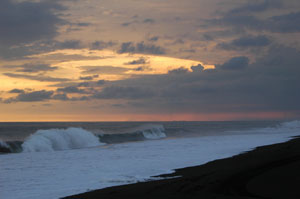 It’s my daughter’s fault that I’m relaxing on a beach here in Monterrico, Guatemala, reminiscing about a fun trip where we mountain biked technical singletrack, explored an ancient Mayan ruin, kayaked across one of the most beautiful lakes in the world and climbed an active volcano searching for flowing lava.
It’s my daughter’s fault that I’m relaxing on a beach here in Monterrico, Guatemala, reminiscing about a fun trip where we mountain biked technical singletrack, explored an ancient Mayan ruin, kayaked across one of the most beautiful lakes in the world and climbed an active volcano searching for flowing lava.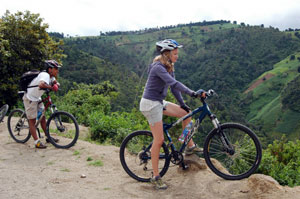 Lesser-known attractions include the country’s vast jungle/rain forest region, its wide rivers (including scenic waterfalls and some whitewater), and a long stretch of Pacific coast beach that is beautiful but almost deserted.
Lesser-known attractions include the country’s vast jungle/rain forest region, its wide rivers (including scenic waterfalls and some whitewater), and a long stretch of Pacific coast beach that is beautiful but almost deserted.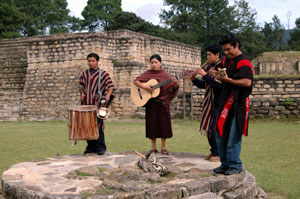 We began by exploring Iximche, a small complex of post-classic Mayan ruins. I learned that indigenous people consider these sites to be sacred. Some come there to burn candles and perform religious ceremonies. While we were there a small group assembled on one ancient structure and played traditional music, some using traditional instruments. The music was beautiful and the performers, in brightly colored costumes, created a memorable scene.
We began by exploring Iximche, a small complex of post-classic Mayan ruins. I learned that indigenous people consider these sites to be sacred. Some come there to burn candles and perform religious ceremonies. While we were there a small group assembled on one ancient structure and played traditional music, some using traditional instruments. The music was beautiful and the performers, in brightly colored costumes, created a memorable scene.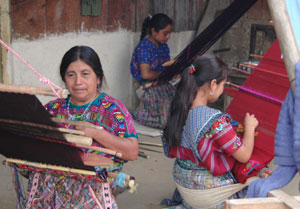 We continued our trek and soon turned off onto a rougher road, which crossed a stream several times. Ah, a little excitement. The road gave way to rocky singletrack, which plunged over cut banks where it crossed the stream. That part of the trail was technical enough that I had to get off and walk my bike over some spots.
We continued our trek and soon turned off onto a rougher road, which crossed a stream several times. Ah, a little excitement. The road gave way to rocky singletrack, which plunged over cut banks where it crossed the stream. That part of the trail was technical enough that I had to get off and walk my bike over some spots.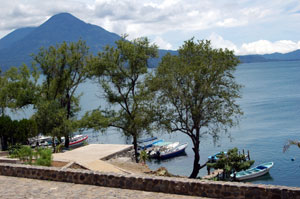 To end our ride we coasted down a paved road through the village of Panajachel, to the shoreline of Lake Atitlan. We ate lunch there and visited the open-air market. My sales resistance was low and I bought more than I intended. It is hard to walk away from the persistent little children and sad-faced old ladies.
To end our ride we coasted down a paved road through the village of Panajachel, to the shoreline of Lake Atitlan. We ate lunch there and visited the open-air market. My sales resistance was low and I bought more than I intended. It is hard to walk away from the persistent little children and sad-faced old ladies.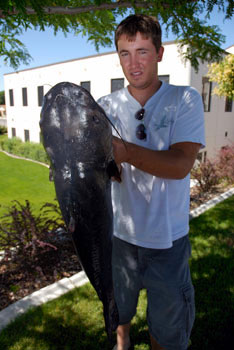 This is from a DWR news release:
This is from a DWR news release: